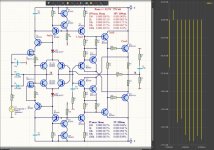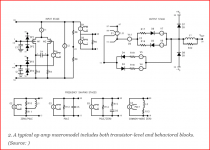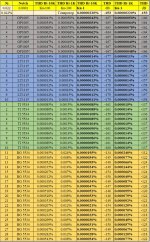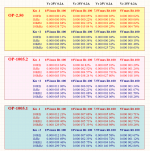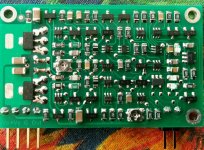The question some will want to know the answer to is, "how does it sound?"
Sure, some people think they have discovered "the formula." Some set of metrics they believe fully define sound quality to humans.
There are other people who find "the formula" to be wrong. That's their particular view of telling 'the truth."
The above said, I have no personal opinion about the circuits of this thread until there are both measurements and listening tests.
Sure, some people think they have discovered "the formula." Some set of metrics they believe fully define sound quality to humans.
There are other people who find "the formula" to be wrong. That's their particular view of telling 'the truth."
The above said, I have no personal opinion about the circuits of this thread until there are both measurements and listening tests.
Last edited:
I don't really get why an i/v converter should have a sound of itself...So do the dac , amps and speakers...i wonder if anyone made a new "audiophile" CIRC circuit for the forgotten bit retrieval...the one that the mastering engineers lost somewhere in the mix...The question some will want to know the answer to is, "how does it sound?"
.
A Dac’s current output is made to look into a virt gnd input, preventing voltage excursions taking place.
The higher the input impedance of the I-V, the higher those unwanted voltage excursions.
And since the current output is far from an ideal current source, those voltage excursions may cause audible distortion.
Hans
The higher the input impedance of the I-V, the higher those unwanted voltage excursions.
And since the current output is far from an ideal current source, those voltage excursions may cause audible distortion.
Hans
We need to know the capabilities of both integrated circuits and discrete ones.
Only then can we use them optimally.
Show us with which integrated circuit you can achieve such parameters.
I thought I did with resp:
0,000 002% @1Khz
0,000 010% @10Khz
0,000 137% @100Khz
Discrete I-V converter
Hans
I can see that this was fun to design. My own fondness for fully complementary designs may be showing. The complexity may not be warranted, but so what. If Sims are true ( often they are not unless stroked correctly to bring out their shortcomings ) the performance is excellent whether there are 3 or 4 zeros in the distortion result. Were there any other design constraints than distortion and noise considered. Cost, size, power, for instance?
These are very wrong results.I thought I did with resp:
0,000 002% @1Khz
0,000 010% @10Khz
0,000 137% @100Khz
Discrete I-V converter
Hans
Can not simulate exactly THD of an integral amplifier model is very simple.
The result of the simulation must always be confirmed by the measurement.
Attachments
Then how did you measure -150db THD on your circuit if everyone else but you is not allowed to show simulation results??These are very wrong results.
Can not simulate exactly THD of an integral amplifier model is very simple.
The result of the simulation must always be confirmed by the measurement.
By the way , i've used 4 different simulation models with the basic virtual ground op-amp i/v and all show -150..-200 db thd and making a more complicated circuit only enhances the ods or the even harmonics, never reducing both of them at the same figures you get with the simplest op-amp model you can find .This topic becomes ridiculous as many others, but I already know a local company selling discrete dac's for 20 000 dollars and you always get an audiophiliac able to swear its new aquisition is better than anything else , the newest review meaning actually that he's advertising its new toy maybe he'd find the next stupid guy to buy it from him and save some damn money or jut get some discount from the company if he's smart enough to give a quick review before others do it first ...That is usually how audiophile componet get upper in price cause no snob is able to admit he lost tons of money on a worthless POS who's same specs or even better could have been purchassed for 100 times less money ...
I have to admit that I'd be seriously envious on anybody selling for serious money a 100 transistor crap that simulates worse than a 1 dollar op-amp simply because I can't do it.
Last edited:
These are very wrong results.
Can not simulate exactly THD of an integral amplifier model is very simple.
The result of the simulation must always be confirmed by the measurement.
I’m sorry, but your information is simply wrong.
Simulation results with modern low noise high speed opamps are most of the time just as accurate as results with discrete circuits, meaning that results with both may be on the optimistic side and everything under -120dB has to be taken with a big corn of salt.
Hans
I see that you do not have the technical knowledge you need to find out what is about the simulation of an integral amplifier.
To be exactly THD, the model should contain all transistors with their exact models as it is in the discrete scheme.
No such complete operating amplifier model.
Look at what one such model contains.
If someone thinks with such models can model Thd it does not understand anything from electronics.
To be exactly THD, the model should contain all transistors with their exact models as it is in the discrete scheme.
No such complete operating amplifier model.
Look at what one such model contains.
If someone thinks with such models can model Thd it does not understand anything from electronics.
Attachments
Last edited:
For which scheme. # ??Sandy, what is the purpose of T9, T14 in unity gain amp circuit?
I see that you do not have the technical knowledge you need to find out what is about the simulation of an integral amplifier.
To be exactly THD, the model should contain all transistors with their exact models as it is in the discrete scheme.
No such complete operating amplifier model.
Look at what one such model contains.
Look dude...some of us actually measured new or ordinary op-amps on AP equipment and saw nothing down to -120db thd ... Hans quotes aren't everyone's cup of tea, but you get " inaccurate" against a well know player round here if you know a little bit of chess...
We can only asume now that you're the only one knowing everything and that is not completly bad, it's called working class with the trial and error method and we are all guilty in the first degree of errors, yet you might need to relax a bit cause some of us aren't exactly carpenters on an embroidery forum while it looks that you are completely exhausted after your simulations...Get a nap, f...your wife, slap your neigbour's children or go fishing all these help a bit, believe me!
Beat be to it dreamth.
trying so hard to appear superior makes you seem insecure Sandy, which i'm sure isnt your objective.
With a little insight into the subtlety of Hans' comment, you see that he is not saying that the IC can be simulated as accurately as a more complete, discrete model; he is saying that the difference between the 2 methods is so small in reality that it is swamped by the difference between simulation and reality in general, so you need to build it and measure in BOTH cases.
trying so hard to appear superior makes you seem insecure Sandy, which i'm sure isnt your objective.
With a little insight into the subtlety of Hans' comment, you see that he is not saying that the IC can be simulated as accurately as a more complete, discrete model; he is saying that the difference between the 2 methods is so small in reality that it is swamped by the difference between simulation and reality in general, so you need to build it and measure in BOTH cases.
Last edited:
Modern op-amps have a THD so small that it cannot be measured directly by any instrument.
However, there are methods of such measurement.
These are real measurements
And simulations
However, there are methods of such measurement.
These are real measurements
And simulations
Attachments
Last edited:
- Home
- Source & Line
- Digital Line Level
- Discrete I-V converter
